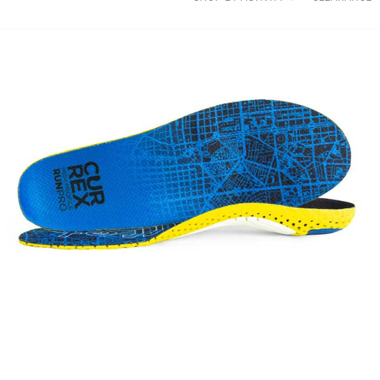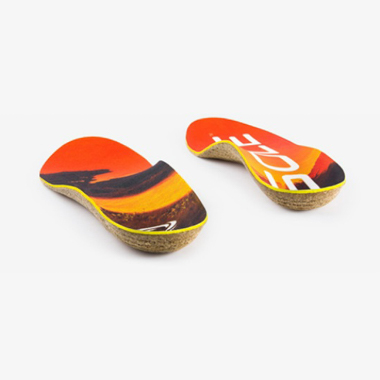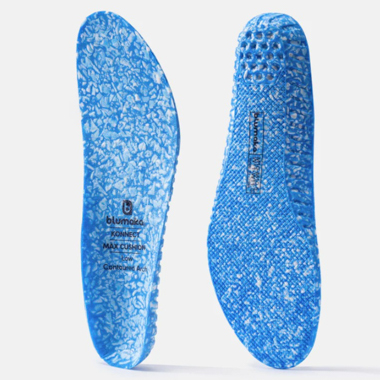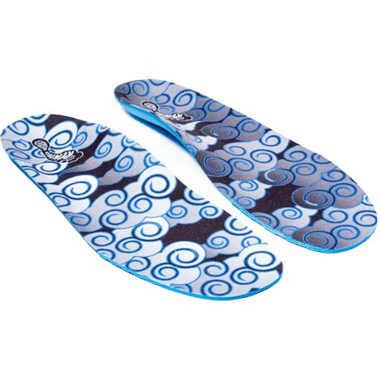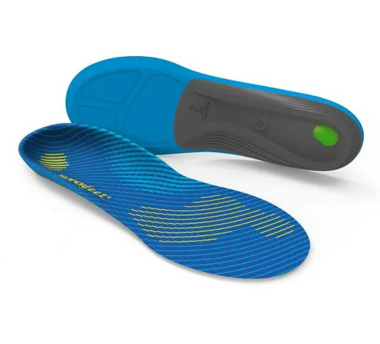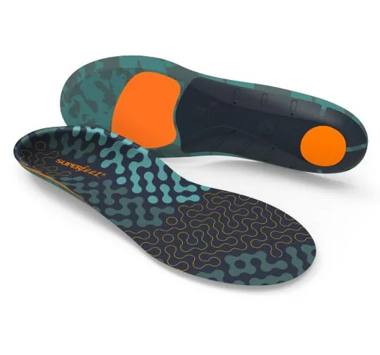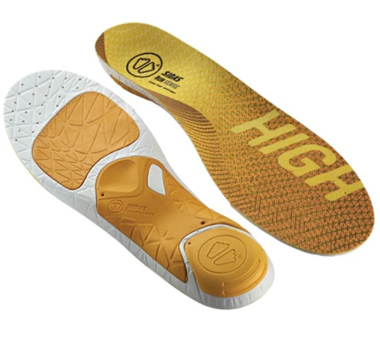
Most runners can benefit from arch support, and the Currex RunPro Insoles were the iRunFar team’s favorites. Photo: iRunFar/Eszter Horanyi
Whether you’re dealing with a foot injury like plantar fasciitis, looking for a bit of extra cushion in your running shoes, or need more arch support than factory footbeds provide, there are several factors to consider when choosing the best running insoles for your needs. With seemingly endless options available, there are a few critical features to consider that can make a big difference.
A well-fitting pair of insoles can help give your foot a more custom fit inside your running shoe by hugging your arch, cradling your heel, and improving your foot’s alignment. Good insoles won’t add too much volume or rigidity or change how the shoe feels when you run.
Over many weeks and months, the iRunFar team — including runners with every variety of arch profile and gait, and some who’ve been dealing with that dreaded plantar fasciitis — have put the best running insoles currently on the market to the test. We put insoles in various types of shoes and took them on as many different surfaces as possible, from flat pavement to technical mountain trails. We also rated the insoles on their comfort, cushion, and support and considered their durability.
Ultimately, we loved the support, fit, and performance of the Currex RunPro Insoles more than any other insole we tested. For those who just want a little bit of extra cushion and don’t need much additional support, the Powerstep Bridge Adaptable Arch Supporting Insoles with Energize Foam is an excellent option at a very affordable price.
Below, we’ve rounded up our top picks to help you with your search. For more background information on this guide, see our buying advice, testing methodology, and frequently asked questions below.
Best Running Insoles
- Overall Best Running Insoles: Currex RunPro Insoles
- Best Moldable Running Insoles: Sole Performance Medium
- Best Running Insoles for Low Arches: Blumaka NonSlip Insoles With Konnect Technology
- Best Budget Running Insoles: Powerstep Bridge Adaptable Arch Supporting Insoles With Energize Foam, Remind Insoles Destin Classic 3mm Low-All Arch
- Other Great Running Insoles: Superfeet Run Support Medium Arch, Superfeet Run Cushion High Arch, Sidas Run 3Feet Sense

The iRunFar team tested various types of insoles to find the best on the market. Photo: iRunFar/Eszter Horanyi
Overall Best Running Insoles: Currex RunPro Insoles ($60)
Pros:
- Low volume and flexible
- Dynamic arch support
Cons:
- Not a standout for durability
The Currex RunPro Insoles were the hands-down favorite among our testing team. These thin and flexible insoles don’t change how your running shoe fits and feels as much as other insoles do, yet there’s no doubt about the support they provide. Testers noted that these insoles felt comfortable right out of the box, and they could immediately wear them for extended periods without breaking them in.
Additionally, we found that these insoles hug the arch without pressing into it. Currex’s dynamic arch design provides support while still allowing the insole to bend and move with the foot. The heel is decoupled from the rest of the arch support and is relatively deep, which keeps the heel in place. The zero-drop design of these insoles means that they won’t change the drop of your shoe.
Although you can trim these insoles with a good pair of scissors, multiple testers reported that they fit right into their shoes with no slippage or trimming necessary. They come in six different sizes, from XS to 2XL, and they fit shoes from men’s 3 to 14.5 or women’s 4.5 to 16. According to Currex’s size guide, you can count on these fitting true to size, and we found this to be true. These insoles are available in three different arch heights — low, medium, and high — so there’s something to fit a wide variety of foot shapes and support needs.
While these insoles are thinner than others we tested, they scored top marks for comfort and support. The bamboo mid-layer provided a good level of cushion and molded to our feet over time. These insoles were comfortable the moment we slipped them into our shoes and became increasingly more so as they molded to our feet over time. Bamboo has natural odor-resisting properties, and we found that these didn’t pick up stink like other insoles.
Our main complaint with these insoles is that they started to show wear after about six months of use and a couple hundred miles. The lifetime for standard running insoles is about 500 to 900 miles, so this breakdown was a little sooner than expected, but not so much so that we’ll discount them entirely. It is worth noting that thicker insoles will last slightly longer.
Materials: Bamboo, foam | Arch profile sizing: Low, medium, high
Shop the Currex RunPro InsolesBest Moldable Running Insoles: Sole Performance Medium ($59)
Pros:
- Super comfortable out of the box
- Available in additional volumes as well as wide-sizing
Cons:
- Too much structure for some
- Cork material feels clunky when wet
The Sole Performance Medium insoles, made from recycled wine corks and EVA foam, offer exceptional comfort and support and some unique features. The main thing that sets these insoles apart from others in this guide is that they can be heat-molded. Because of this, these insoles are not available in different arch profiles. When you mold them, the arch height will naturally form to your foot. They come in 14 sizes, so you probably won’t have to trim them to fit your shoes.
The heat molding process is relatively simple and easy: put the insoles in a conventional oven set at 200 degrees Fahrenheit for two minutes, then place them in your shoes, step in, and stand or walk around. If you don’t want to deal with the heat molding process, they will gradually shape to your feet as you wear them.
Our testers agreed that these insoles felt very comfortable right out of the box and required no break-in period, so no one on our testing team opted to heat-mold them. The heel cup is deep and supportive, cradling the back of the foot.
While testers loved the comfort and support these insoles provide, they noted that they feel very structured compared to other running insoles they tested — however, that was not necessarily bad. Testers appreciated the extra support for their tired feet on recovery runs. The extra structure provided guidance toward healthy foot alignment without changing our stride.
None of the runners who tested these insoles were dealing with foot issues, but they noted that someone with plantar fasciitis or a toe injury might appreciate the extra structure and support. A small metatarsal support pad underneath the toes might help with a neuroma or similar forefoot issues.
These insoles have a Polygiene anti-odor treatment to help reduce smell, and they come with a 90-day satisfaction guarantee in case they don’t work for your feet.
The only real downside of these insoles is that when they get wet, they feel clunky inside your shoes — so, heads up to trail runners who regularly splash through streams or mud.
Materials: Recycled cork and EVA foam | Arch profile sizing: One size (heat- and wear-moldable)
Shop the Sole Performance MediumBest Running Insoles for Low Arches: Blumaka NonSlip Insoles With Konnect Technology ($60) Rewrite
- It has a nice balance of structure and cushion
- Comfortable and supportive heel cup
- Grippy anti-slip surface helps keep feet planted on uneven surfaces
Cons:
- Less arch and metatarsal support than other options
- There is not enough support for high arches
The Blumaka NonSlip Insoles with Konnect Technology are much more flexible than many of the other insoles in this guide, but they will cushion and support your feet, especially if you’re running hard downhill or on technical trails. They’re a good choice if you prefer more flex than rigidity with your running insoles. They have a very deep heel cup that cradles the heel comfortably and provides a good amount of cushion.
This insole comes in two options: max cushion and low profile. We tested the max cushion insole, and the brand recommends the low-profile one for sports that use racing flats or cleats, such as soccer, track, and lacrosse. Within these two options are three different arch height options: low, medium, and high.
The brand’s main claim with these insoles is that they keep your feet from slipping around inside the shoe. We found the topper material to hold our feet in place, but we don’t know if it’s noticeably more so than other insoles. We were much more appreciative of the extra cushion and flexibility. Made with 85% recycled ETPU (expanded thermoplastic foam), which is soft and bouncy, these insoles take less water and energy to make than others, so they have a smaller environmental footprint.
Designed for people with low to medium arches, they may lack the support that someone with high arches needs. We also found that these insoles didn’t provide much support through the metatarsal region, so if you’re dealing with forefoot issues, these may not be the insoles for you.
These insoles won’t provide a huge level of rigidity or support, but they will improve comfort and provide a bit more support than factory insoles. If you’re just looking for extra cushion for long days on your feet but don’t feel like your feet need a huge amount of support, these could be a great option.
Materials: Recycled ETPU foam | Arch profile sizing: Low profile, max cushion
Shop the Blumaka NonSlip Insoles With Konnect TechnologyBest Budget Running Insoles
Powerstep Bridge Adaptable Arch Supporting Insoles With Energize Foam ($35)
Pros:
- Comfortable cushion
- Flexible
- Good value for a basic footbed replacement
Cons:
- Not as structured or supportive as other options
- Could feel too plush for some runners
While most running insoles fall within a price range of $50 to $70, there are a few lower-cost options that our testers deemed a great value, including the Powerstep Bridge Adaptable Arch Supporting Insoles with Energize Foam. This insole is a great option for runners looking for a high-quality footbed to replace their shoe’s factory liner but who don’t necessarily need special support. This insole features a few different foams, including a bouncy one for energy return and memory foam for supreme comfort.
These super flexible insoles make them great for running, but they lack the structure and support of some of the other insoles in this guide. Nonetheless, they have the potential to provide pain relief and address minor foot issues. We found that the extra bit of cushion and structure they provided made a big difference in the comfort of their shoes, especially after many hours on the move. They’ll certainly do a better job than the basic footliners that come in most running shoes.
We appreciated that these insoles felt comfortable immediately, especially on the heel. While they may not be our top pick if we were looking for a high level of arch support, they’re a good option for daily training runs, especially recovery runs where you want some added plushness underfoot without changing your shoes’ overall fit and feel.
Materials: Foam blend, including memory foam | Arch profile Sizing: One size
Shop the Powerstep Bridge Adaptable Arch Supporting Insoles With Energize FoamRemind Insoles Destin Classic 3mm Low-All Arch ($25)
- It molds to your foot shape as you wear it
- It adds just a bit of added cushion and support
Cons:
- It is relatively basic compared to other insoles
- Not a huge upgrade from a stock insole
Our testers offered mixed feedback about the Remind Insoles Destin Classic 3mm Low-All Arch insoles, but they’re worth considering if you’re looking for a basic replacement for your shoe’s stock insert that doesn’t cost very much. While some testers loved these insoles for the subtle increase in support and cushion, others found them underwhelming.
The insoles are constructed with a proprietary blend of materials and designed to help cushion and diffuse the impact of each foot strike and provide a higher energy return than stock footliners. These insoles have a low-profile, three-millimeter thickness, though they’re also available in a slightly thicker five-millimeter version, and they mold to your feet as you use them.
These insoles are better suited to those with low and medium arches, as those with high arches might find the support underfoot lacking. Among our testers who overpronate, some found that these didn’t provide the level of support they wanted, while others liked the subtle, low-profile cushioned feel and said they would use these again in the future.
The forefoot of the insole is three millimeters thick, and the heel is 5 millimeters, so they add a two-millimeter drop to your shoe. This could be something to consider if you’re concerned about shoe drop.
If you’re looking to upgrade the comfort of your shoes without adding any rigidity or support, these could be a low-cost investment. They could also work for people who are sensitive to the fit and feel of their shoes. On the other hand, if you like the support of a firm hug underneath your arch and heel, you’ll be better off choosing one of the other more supportive insoles above.
Materials: Proprietary blend | Arch profile sizing: One size. Also available in a thicker, five-millimeter version
Shop the Remind Insoles Destin Classic 3mm Low-All ArchOther Great Running Insoles
Superfeet Run Support Medium Arch ($55)
Pros:
- Supportive fit out of the box
- Comfortable with minimal break-in period needed
Cons:
- Some durability concerns
Formerly known as the Run Comfort Thin, the Superfeet Run Support Medium Arch is another excellent all-around running insole, whether you’re dealing with foot issues or trying to avoid them. Superfeet has been making insoles for a long time and are some of the most widely available and popular options on the market. Because they make so many different insoles, there really is something for nearly any foot type.
These particular insoles have a medium arch and mid-thickness foam and will work for many different types of feet without feeling overwhelming. They have a single layer of foam cushioning and a carbon fiber cap underneath the arch and heel to provide stability, structure, and rebound. The heel cup, an area that naturally receives a fair bit of impact during most people’s running stride, is well-padded and secure.
If you have low or high arches, the SuperFeet Run Support Low Arch insoles have thinner foam, and the Superfeet Run Support High Arch insoles have thicker foam and are also better for low- and high-volume shoes, respectively. The SuperFeet Run Women’s Support Insole also works for medium to high insoles with thicker foam than the other options in the Run line.
We found that the insoles we tested were comfortable and out of the box and fit true to size with zero or minimal trimming. One tester emphasized the importance of lining up this insole with your arch before trimming it down, which is excellent advice for using any insole.
These insoles scored highest in support and fit amongst our testing team. Some testers noted that they felt the difference in arch support right away, and others appreciated that they didn’t notice the insoles at all. The only note of concern was that one tester noticed the insoles’ foam starting to get packed out after about 75 miles, which is much sooner than expected.
Superfeet claims its insoles keep their shape for 12 months or 500 miles and offer a 60-day guarantee. If you opt for Superfeet insoles, consider watching for signs of excessive wear during that initial 60-day window.
Materials: Foam, carbon fiber | Arch profile sizing: Low, medium, high, and women-specific (note: “Support” insoles with different arch profiles also have different thicknesses)
Shop the Superfeet Run Support Medium ArchSuperfeet Run Cushion High Arch ($55)
Pros:
- Very comfortable for both running and all-day wear
- Bouncy
- Flexible
Cons:
- Too much stack if you prefer a low-profile insole
Our top choice for a maximum support insole is the Superfeet Run Cushion High Arch, previously called the Adapt Run Max. These insoles were a huge hit among our testers, some of whom are more familiar than they’d like to be with plantar fasciitis. In addition to using them for running, some of our testers stand all day for work and choose to wear these insoles all day, every day.
Superfeet’s Cushion line prioritizes cushion and flexibility, making these a very comfortable option if you’re constantly on the go. Even with maximum cushion, testers didn’t feel like these insoles were taking up too much space underfoot or pushing their feet out of their shoes, though they may be too much for people who prefer lower-profile insoles or wear low-volume shoes.
These insoles have a softer underfoot feel than the Superfeet Run Support Medium Arch above. Instead of the carbon heel cap, which adds firmness, they have bouncy foam in the heel and forefoot to enhance rebound and energy return. While testers loved the instant comfort of these insoles and their applications beyond running, they also noted their relative thickness compared to others. Some runners will love the extra cushion, while others may find them a little too much.
Materials: Proprietary Aerolyte foam | Arch profile sizing: Also available in a low-arch profile with the same thickness
Shop the Superfeet Run Cushion High ArchSidas Run 3Feet Sense ($55)
- Relatively thin
- Supportive
- Extra support under the ball of the foot and heel
Cons:
- Not as high of an arch as other options
The Sidas Run 3Feet Sense insoles came into our testing program when one of our testers showed up for a multi-month trip in New Zealand and realized that she hadn’t packed insoles for her running shoes. She wandered into a running store, asked for a pair of insoles most closely resembling the Superfeet Run Support High Arch insoles she’d so conveniently left at home, and walked out with these.
After five months of use in environments known for destroying gear due to endless wet conditions, glacial silt and scree in shoes, and mud, she deemed these insoles comfortable, durable, and a pair that she’d get again in the future, maybe even instead of her go-to Superfeets.
These insoles are fairly thin, and extra perforations under the toes theoretically increase their breathability. The main material is EVA foam, and an added heel pad provides extra cushion. The arch is well-placed and comfortable, and we didn’t find that they dug into our feet at all. That said, they feel less supportive than other high-arch insoles, but that’s not necessarily a bad thing. These insoles come in three different arch heights: low, mid, and high, and they’re available in six different sizes that you can trim down to fit your specific shoe size and shape.
The insole features a merrymesh top cover, which has proven more durable than many other insoles. We’ve had issues with the top material of other insoles deteriorating and peeling under our heel, but these continue to hold up to incredibly difficult conditions. We also haven’t noticed them packing out after many miles.
These aren’t the thickest, thinnest, most supportive, or least supportive of the insoles in this guide, but they’re a great middle-of-the-road option for those looking for a bit of extra support and cushion.
Materials: EVA foam | Arch profile sizing: Low, mid, high
Shop the Sidas Run 3Feet SenseComparing the Best Insoles for Running
| INSOLE | PRICE | MATERIAL | ARCH PROFILE |
| Currex RunPro Insoles | $60 | Bamboo, foam | Low, medium, high |
| Sole Performance Medium | $59 | Recycled cork, EVA foam | One size |
| Blumaka NonSlip Insoles With Konnect Technology | $59 | Recycled ETPU foam | Low arch support, max cushion |
| Superfeet Run Support Medium Arch | $55 | Foam, carbon fiber | Low, medium, high, and women’s-specific |
| Superfeet Run Cushion High Arch | $55 | Polyurethane memory foam, EVA foam | Regular, low |
| Powerstep Bridge Adaptable Arch Supporting Insoles With Energize Foam | $35 | Foam blend | One size |
| Remind Insoles Destin Classic 3mm Low-All Arch | $25 | Proprietary blend | One size |
| Sidas Run 3Feet Sense | $55 | Eva Foam | Low, mid, high |
Glossary
- Arch Profile – A measure describing how much your foot touches the ground when standing. It is also called arch height. Generally, your arch profile and how flexible or rigid it is determines how your foot absorbs impact when you run, including its pronation and supination.
- Pronation – The natural inward collapse of the foot’s arch as it absorbs and distributes impact while running or walking.
- Overpronation – When the arch’s inward collapse exceeds the normal range. This can lead to pain in the arches, ankles, Achilles tendons, shins, outer knee, and outer hip.
- Supination – When the arch doesn’t collapse enough, and the outside of the foot absorbs the impact while running or walking. This is also called underpronation and correlates with high arches. It can also be associated with plantar fasciitis and pain in the pelvis and lumbar spine.
- Plantar Fasciitis – Inflammation of the plantar fascia tissue on the bottom of the foot that connects the toes to the heel bone. It is often associated with intense pain on the bottom of the foot near the heel.
- Morton’s neuroma – A thickening of tissue and inflammation around the nerves in the foot that causes discomfort or pain in the ball of the foot between the third and fourth toes.
- Achilles tendinitis – Inflammation of the tendon that connects the calf muscles to the heel bone.

With a wide variety of insoles on the market today, there’s something for nearly any type of runner. Photo: iRunFar/Eszter Horanyi
How to Choose the Best Running Insoles
Different Arch Profiles
Understanding your arch profile and natural gait is an important first step to choosing the best running insoles for your specific feet and running gait. Your insole choice will depend on your arch profile and whether you overpronate, underpronate, or have a more neutral gait. Most brands design insoles with either low, medium, or high arch profiles, and most models, including the Currex RunPro Insoles, Superfeet Run Support, and Sidas Run 3Feet Sense, have different options available.
Additionally, it’s essential to understand your gait when selecting an insole, especially if you have a high arch and underpronate. An insole with a high arch profile could push your stride further to the outside of your feet, leading to pain or injury. If you know you overpronate severely, consider using a stability shoe instead of just an insole. You can check out some top options in our Best Stability Running Shoes guide.
There are several ways to measure your arch profile. Your best option is to visit your local specialty running store and ask one of the employees to analyze your arches and gait. They do this all day long and will quickly be able to offer information and shoe and insole recommendations. If you don’t have a local running shop, you can also wet your foot and step on a dark piece of paper, such as cardboard or brown packaging paper, to see how much of your arch touches the ground.
Be sure to measure both arches because they may not be the same. You can analyze your arch profile based on how much of your wet foot touches the paper. As for your gait, you could also ask a running buddy to watch your feet as you walk or run to see whether your feet roll noticeably inward or outward. If you have fairly average arches, an insole like the Blumaka NonSlip Insoles with Konnect Technology could provide extra cushion without overwhelming you with too much support.
Your foot shape can also change as you run. A study has found that the navicular, a bone found in the midfoot, can drop up to five millimeters after running a half marathon distance, effectively collapsing the arch, and stay that way for over a week after the effort (1). The study speculates that this drop is due to a lessening of the plantar fascia stiffness.
A different study found decreased plantar fascia stiffness after running (2). Foot and arch shape can also change over time, so it’s worth checking in with your arches occasionally over the years to see if you notice any changes.
Level of Stiffness and Rigidity Versus Flexibility
Aside from being low, medium, or high, arches can be rigid, flexible, or anywhere in between. Rigid arches remain fixed and move very little when standing, walking, or bearing weight. With a flexible arch, the arch will be visible when unweighted, but it flattens when under load. Typically, overly flexible arches are associated with overpronation and related pains and injuries, while overly rigid arches are associated with supination and related issues.
An insole like the Sole Performance Medium, which provides a fair bit of structure and support, can help prevent overpronation and potentially reduce the chance of overuse injuries, including plantar fasciitis. If you overpronate too much, your best option might be to check out our Best Stability Running Shoes guide.

The Blumaka NonSlip Insoles with Konnect Technology insoles have a 90-day money-back guarantee. Photo: iRunFar/Eszter Horanyi
Insole Volume
Most running insoles will simply replace a running shoe’s footbed with a more customized fit and supportive experience, and they won’t noticeably change the volume inside the shoe. A simple insole like the Powerstep Bridge Adaptable Arch Supporting Insoles with Energize Foam is thin and flexible enough to provide extra support without changing the fit and feel of the shoe. The Currex RunPro Insoles also closely match the thickness of a running shoe’s factory liner but provide a lot more support and cushioning. Once you replace the factory liner with the running insole, the fit should feel nice, like a hug.
That said, some insoles are designed to be more supportive and may have more volume due to thicker cushioning or more built-up arch support to address plantar fasciitis in particular. The thickness of the Superfeet Run Cushion High Arch provides a lot of cushion but can take up a lot of volume in a shoe. Finally, custom orthotics can significantly change how a shoe fits and feels. With all this in mind, the best way to ensure a good fit is to try on your running shoes and insoles together before purchasing. Insoles should be comfortable and not make a shoe feel too small.
Price
Most of the running insoles in this guide fall between $50 and $60, with two top picks, the Remind Insoles Destin Classic 3mm Low-All Arch and the Powerstep Bridge Adaptable Arch Supporting Insoles with Energize Foam, available for a lower cost. Note, however, that the less expensive insoles are basic footbed replacements, meaning that they’re an excellent alternative to a running shoe’s factory liner, but they don’t provide a lot of extra arch support. Additionally, specialized insoles for issues like plantar fasciitis may exceed the price range in this guide, and custom orthotics can be very expensive.
Durability
Most of the best running insoles will last at least as long as your running shoes, and they may even get you through two pairs. Many brands claim a 500- to 900-mile lifetime for their insoles, but as with shoes, exactly how long the insoles last will depend on several factors, including the terrain you run on. If you’re the type of person who goes through running shoes very quickly, your insoles will likely wear out faster, too.
We found that the Currex RunPro Insoles started to show wear sooner than expected, though it wasn’t a significant enough issue to outweigh the other things we loved about the insole. Our team also found that the Superfeet Run Support Medium Arch started to pack out quicker than we had hoped. The Sidas Run 3Feet Sense High insoles showed impressive durability under difficult conditions.
To determine when to replace your running insoles, you can examine them for visible wear. Additionally, as with your running shoes, if your feet feel unusually tired and achy or your shoes feel less supportive, it’s probably time for a fresh set of insoles, running shoes, or potentially both.

After a full summer of use in New Zealand, the Sidas Run 3Feet Sense showed remarkably little wear. Photo: iRunFar/Eszter Horanyi
Over-the-Counter Insoles Versus Orthotics
For most runners, over-the-counter insoles, even the lower-support Powerstep Bridge Adaptable Arch Supporting Insoles with Energize Foam ones, offer plenty of support for everyday comfort and can help to deal with minor aches, pains, and overuse injuries. On the other hand, if you’re dealing with chronic pain, issues relating to your bone structure, or a serious medical condition, the best solution may be custom orthotics, which you would get from a podiatrist.
If you want more customizable insoles, consider the Sole Performance Medium, which can be heat-molded. We recommend working with your doctor, physical therapist, or other medical professional to determine your best option.
Heat Molding or Other Customization Features
Some insoles, like the Sole Performance Medium, can be custom molded using heat or other methods. Even without heat, some insoles mold to your feet more significantly than others. This process, whether just heat or time, helps the insoles form to your feet for a comfortable and customized fit.
Insoles with soft foam and more cushioning will typically form to your feet more quickly than insoles constructed with harder foams, plastics, or carbon fiber. Regardless of customization options, insoles may take some time to break in and feel very comfortable. Your insoles should never feel painful or press uncomfortably into your arches. If you notice this, you should stop wearing them and switch them out for different insoles.

Insoles can fit nearly any type of shoe, though a thinner insole might be best if you’re wearing low-volume shoes. Photo: iRunFar/Eszter Horanyi
Why You Should Trust Us
We compiled this best running insoles guide using the expertise and testing experience of the iRunFar team. Author Alli Hartz supplemented it with extensive research and input from seasoned running gear experts at iRunFar.
We began by compiling and considering a list of more than two dozen running insoles currently available. We then sent our top picks to our testing team, which included runners with every type of arch profile and gait and some who had experienced plantar fasciitis, Achilles tendinitis, or other foot-related injuries. Our testers tested the insoles for several weeks, some of them for many months, collectively putting hundreds of miles on each style of insole.
We rated insoles on comfort, durability, support level, cushion, and fit within a shoe. With all the testing feedback, we finalized our list of the best insoles in this guide to help you choose the best option for your specific foot type and running needs.
Frequently Asked Questions
What is a running insole for?
The best running insoles, such as our top choice, the Currex RunPro Insoles, can help provide arch and heel support you don’t get from the factory liner that comes with your running shoe. An insole can help provide a more customized fit within the shoe and provide a higher level of support for your entire foot, which may help prevent injuries. Insoles can also address overpronation by placing more structure underneath your arch, keeping it from collapsing inward.
People with a high and flexible arch can be susceptible to overpronation, which can lead to a host of injuries ranging from Achilles tendinitis to plantar fasciitis. Providing extra arch support can take the stress off the plantar fascia and reduce the inflammation associated with the injury.
A properly fitting and well-cushioned insole can also reduce foot fatigue and minimize achy feet. Finally, remember that your feet are the foundation for everything else. Supporting your feet can also help reduce pain or discomfort elsewhere in the body, such as the knees, hips, and back.
Do running insoles make a difference?
Yes, running insoles can help keep your feet well-supported and aligned, which helps the rest of your body stay aligned. The key is choosing insoles to ensure they fit your shoes properly and match your arch profile and gait. If you’re using insoles unsuitable for your arch and gait, you could exacerbate current issues or create new, painful problems for yourself.
Someone who doesn’t need much support could benefit more from a less structured insole, like the Powerstep Bridge Adaptable Arch Supporting Insoles with Energize Foam or the Remind Insoles Destin Classic 3mm Low-All Arch, instead of one with a lot of rigid arch support.
What are the benefits of insoles?
Insoles can improve and enhance the fit and comfort of your running shoes. This can help you run more comfortably, prevent or reduce inflammation, and minimize fatigue in your feet. Insoles can also help keep your feet aligned throughout your running and walking stride, supporting and improving your posture by supporting your arches and heels.
Most insoles have a relatively deep heel cup in order to keep the hindfoot properly aligned and remove lateral motion. The Superfeet Run Support Medium Arch has a deep heel cup with a carbon fiber cap to provide extra structure and support.
When sizing insoles, brands’ sizing guides are a good start, but when you try them in your shoes, you want to ensure that your heel fits firmly in the heel cup instead of sitting on top of it. The rest of the insole can then be trimmed to the size of your shoe if needed. A well-aligned foot can ease tightness or pain in the feet, knees, hips, and back.
The additional cushion provided by insoles can also reduce the pressure on your feet and improve comfort. Extra cushion in the heel can especially benefit those who run with a heel-striking gait. Some insoles that provide arch support and extra cushion, like the Superfeet Run Cushion High Arch, are excellent options for all-day wear for people working on their feet.

Whether you overpronate, underpronate, or have a neutral stride, an insole can provide extra cushion and align your feet and ankles. Photo: iRunFar/Eszter Horanyi
What are the best insoles for running?
The best running insoles are the ones that match your specific arch profile and your natural gait, whether you overpronate, supinate, or run neutrally. We highly recommend analyzing your arch and gait at a specialty running store before purchasing running insoles. If you don’t have access to a running store, trust that the most comfortable insoles are the ones that are most likely the best for your feet and gait.
In a study of military recruits who were given the option of six different insoles and allowed to wear the ones most comfortable for them, they had a 14% less chance of injury, including stress fractures, than the control group (3). You don’t necessarily need a professional gait analysis to know what feels comfortable for your body. That said, if you’re dealing with any sort of injury, seeking a professional opinion can help you understand how insoles can change your running mechanics to address it.
Our top pick for the best running insoles was the Currex RunPro Insoles, which come with three arch-height options and can fit a wide variety of feet.
How long do insoles last?
Running insoles should last at least as long as your running shoes. Depending on the type of insole and how hard you wear it, they may last through a couple of pairs of running shoes. In general, you can count on your insoles to last anywhere from 500 to 900 miles. Examining your insoles for visible wear, just like you would with running shoes, will help you determine when it’s time to replace them.
If your insoles have visibly deformed or the top lining layer has started to peel, it’s probably time to replace them. We were impressed with how long the Sidas Run 3Feet Sense High lasted, even under difficult and wet conditions that would have destroyed many other options.
Additionally, if your feet feel unusually tired and achy or your shoes feel less supportive, it’s most likely time for new insoles. Thinner insoles like the Currex RunPro Insoles may not last as long as thicker options like the Superfeet Run Cushion High Arch.

Insoles, like shoes, should be replaced regularly before they start looking like this. Photo: iRunFar/Eszter Horanyi
Should everyone run with insoles?
While not everyone will benefit from highly supportive insoles, it’s hard to argue against adding a bit more cushion to your shoes with a flexible insole like the Powerstep Bridge Adaptable Arch Supporting Insoles with Energize Foam. Studies have found that 74% of runners sustain at least one moderate to severe injury per year, and those who are heel strikers are twice as likely to deal with issues [4]. Having extra cushion under the feet, especially the heel, can protect your feet from the stresses of the repeated impacts of running.
For people who want more arch support than what factory footliners provide, insoles can make a big difference. It’s important to make sure that both your running shoes and insoles are the right match for your arch profile and gait. If you supinate, you may want to skip insoles altogether or use an insole with a low or medium arch profile height so as not to tip your feet even more to the outside.
Most of the insoles included in this guide, including the Currex RunPro Insoles, Superfeet Run Support Medium Arch, and Superfeet Run Cushion High Arch, come with different arch profile options so that you can choose one that fits your foot shape and arch profile.

Our testers with plantar fasciitis loved the Superfeet Run Cushion High Arch insoles. Photo: iRunFar/Eszter Horanyi
What are the best insoles for plantar fasciitis?
Since plantar fasciitis stems from stress and inflammation of the band of tissue underneath the arch that connects the heel to the toes, reducing stress on it may help treat and prevent the injury. Adequate arch and heel support that can disperse pressure across the entire base of the foot can alleviate the stress placed on the plantar fascia, which is exactly what insoles do. People suffering from plantar fasciitis often find that a slightly more rigid and supportive insole, like the Sole Performance Medium, works best.
If you’re dealing with any sort of injury, it’s always a good idea to talk to a medical professional to discuss your best treatment options.
Do professional runners use insoles?
Runners of every variety use insoles, including professional, elite, amateur, recreational, and novice runners. The fact is, nearly every runner can benefit from arch support. The key is to make sure you’re choosing the best running insoles for your unique foot shape and running gait, whether you need the high level of support provided by the Sole Performance Medium or something much less, like the extra cushion offered by the Powerstep Bridge Adaptable Arch Supporting Insoles with Energize Foam.
Do insoles help with knee pain?
This will depend very much on the root cause of the knee pain, and we recommend that you consult a medical professional about any sort of injury. Running insoles can help with some types of knee pain, especially when it stems from overpronation or collapsing arches. Adding moderate support, like that provided by the Superfeet Run Support Medium Arch, may help with certain types of knee pain by helping your feet have better alignment throughout your stride.
Of course, there are many types of knee pain, and insoles won’t fix everything. If you’re experiencing knee pain, we recommend working with a medical professional to understand the cause and follow their recommended treatment plan.

iRunFar’s Alli Miles loved the Superfeet Run Cushion High Arch for their support and comfort. Photo: iRunFar/Eszter Horanyi
Do insoles help with shin splints?
Yes, insoles can help with shin splints. Shin splints stem from inflammation and tearing of the ankle-stabilizing muscles that attach to the shin bone, typically from overuse or too much intensity. Running insoles like the Sole Performance Medium can help support, align, and stabilize the foot, alleviating the stress on those stabilizer muscles and reducing inflammation.
That said, other treatments may be necessary depending on the cause and severity of the shin pain. We recommend working with a medical professional, such as a physical therapist, if you’re dealing with shin pain.
Related Articles
Call for Comments
- Do you use insoles for running? Why or why not?
- Do you have a brand or style of running insoles that’s worked well for you?
Notes/References
[1] Cowley E, Marsden J. The effects of prolonged running on foot posture: a repeated measures study of half marathon runners using the Foot Posture Index and navicular height. J Foot Ankle Res. 2013;6:20. doi: 10.1186/1757-1146-6-20
[2] Shiotani H, Mizokuchi T, Yamashita R, Naito M, Kawakami Y. Acute effects of long-distance running on mechanical and morphological properties of the human plantar fascia. Scand J Med Sci Sports. 2020;30(8):1360-1368. doi: 10.1111/sms.13690
[3] Mundermann A, Stefanyshyn DJ, Nigg BM. Relationship between footwear comfort of shoe inserts and anthropometric and sensory factors. Med Sci Sports Exerc. 2001;33(11):1939-1945. doi: 10.1097/00005768-200111000-00021
[4] Daoud AI, Geissler GJ, Wang F, et al. Foot strike and injury rates in endurance runners: a retrospective study. Med Sci Sports Exerc. 2012;44(7):1325-1334. doi: 10.1249/MSS.0b013e3182465115
